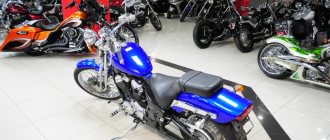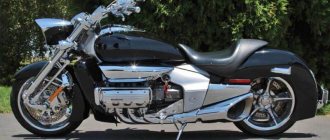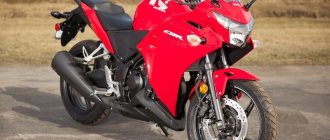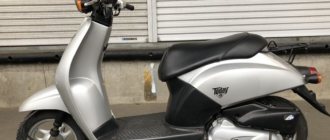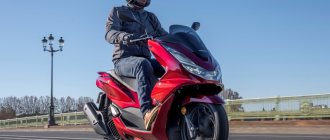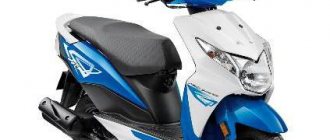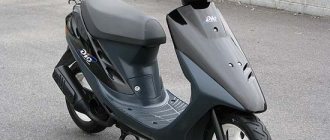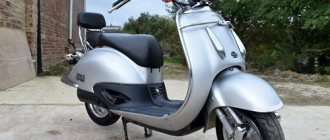Japanese motorcyclesHonda motorcycles
Japanese motorcycles of the famous Honda brand have always been famous for their excellent driving performance, power and reliability of power units, impeccable appearance and exceptional style.
The new product of Japanese engineers, named Honda NC 750 XD, was no exception.
The NC 700 series dates back to 2011, when the bike was presented to the public during the World Exhibition in Milan. Just two years later, the model received a larger engine, increased comfort and new software for a unique robotic gearbox.
It was this updated modification of the enduro, which received the XD prefix, that became an undoubted bestseller in its class.
Popularity of the model
The demand for a two-wheeled crossover from Honda is explained by many by the presence of an innovative automatic transmission, or more precisely, a unique robotic clutch .
However, the Honda NC 750 XD model is also attractive for bikers due to its incredible convenience and comfort , very modest fuel consumption and impressive engine power.
Thanks to a competent combination of operational and technical characteristics, as well as an increased level of safety, the motorcycle has become universal, which makes it possible to use it both for everyday trips and for long trips.
This certainly attracted the attention of many motorcycle fans to the Japanese “horse”.
The NC 750 XD motorcycle has a fast, aggressive and modern exterior.
It is equipped with effective optics , the light of which perfectly illuminates the road, an electronic liquid crystal instrument panel with odometer, speedometer and tachometer scales, a fuel gauge and other systems, as well as a convenient, comfortable seat designed for two people.
The basis of the design of the Honda HC 750 is a compact and lightweight diagonal tubular frame made of steel. It is characterized by high rigidity, which has a positive effect on the bike's handling.
The V-belt variator, telescopic front fork and rear suspension pendulum with monoshock absorber do an excellent job, leaving a pleasant riding impression and smoothing out all the bumps in the road.
The sports Honda CBR 600 RR, the characteristics of which are described in detail in our review, holds the speed record for production motorcycles with a 600 cc engine.
This popular 400 cc model from Honda was initially produced for the domestic market, but over time they decided to release it on other continents.
Test drive of the Honda NC750XD (DCT) model from Gazeta.ru
Honda NC750 motorcycle equipped with an automatic transmission for a close acquaintance , the Gazeta.Ru correspondent seriously thought about the right of “automatic motorcycles” to life and about who and how they can help.
Automatic on a motorcycle? Yes, this happens. And scooters have nothing to do with it: CVTs are installed on two-wheeled “stools”, “sofas” and “sofas”, and this thing does not suit the character of a motorcycle - about the same as pointe shoes for a boxer. That's why the Honda NC750 has a real gearbox. Well, that is, like a real, preselective, robotic one - much like the Volkswagen DSG and its numerous analogues.
Only, unlike the specialists from Wolfsburg, the engineers from Tokyo did not stoop to dry clutches and allowed the dual assembly of their gearbox to bathe in special oil - this is even more important for a motorcycle than for a car.
Honda NC750 is a unique motorcycle in its own way. It can be purchased in two designs and with two transmission options - traditional and automatic. To be fair, it should be noted that the second option is not unique: you can choose a box when buying a fashionable sports tourer with the VFR index, but different designs are, of course, interesting. Apart from this, the NC750 has another interesting feature: what everyone thinks is a fuel tank is actually a housing that can easily accommodate a helmet.
Well, or any other stuff that other motorcyclists are forced to carry in panniers or backpacks.
But all these are small things compared to the ergonomics of the automated version. Of course, there is no left “foot” here, but it can be ordered for an additional fee. But what’s tricked out on the steering wheel will remain there: the transmission mode selector, the manual mode switch, the up and down keys for the index finger and thumb of the left hand, and even the parking brake lever. Well, what about without a “handbrake”? You can't leave the motorcycle in gear.
So here everything is like a car: when you get ready to drive, don’t forget to release the parking brake. Otherwise, there are no special nuances: I started it, turned the gearbox into “drive” with my right thumb, turned the knob, and off I went.
The clutches work exemplary. The NC750 accelerates without fire, it doesn’t turn on the rear wheel, but this blandness successfully masks a very impressive pace. Before you have time to look back, the speedometer already shows “one hundred.” Suddenly.
In general, this “Honda” fascinates with its “relaxation”. Accelerate faster? Please. To turn? No problem. Turn sharper? No problem at all! Of course, it’s hard to call the chassis assembled, but the suspension warns the pilot in advance that the limit is close and it’s better not to tempt fate. Moreover, even a not very experienced pilot can pick up the signals.
Another thing is “automatic”. In principle, it is not difficult to get used to it. There is no need to think at all when accelerating, and downshifting during braking occurs smoothly and predictably. I did, however, notice how my brain had reorganized itself: after an hour I was braking not to the required speed, but to the desired gear, carefully monitoring the operation of the gearbox. A little strange, of course, but you can live. In the end, for the lords of iron there is a sport mode and a lever that puts the box entirely under the control of the pilot.
The latter is especially useful when “piercing” traffic jams - not even to change gears on your own, but to eliminate the arbitrariness of the machine: you never know what will come into his electronic head?
Therefore, the mechanism of movement in “cramped conditions” looks like this: we release the brakes to the second, pull the manual mode lever with the right indicator, and then - depending on the situation: either we roll on low gas, or we hold the motorcycle in the rear. Nothing complicated, in general, but you still need to think. It's even more important not to turn off your brain and rely on your electronic brain when going through long corners. Any motorcyclist knows the consequences of a sharp downshift during a long, high-speed ride, and even on wet asphalt.
Checking, needless to say, was alarming. But there is nowhere to go.
Long right, fourth gear, drive mode, speed - 80. Careful release of the gas... Yes! The gearbox pushes into third smoothly, but this is still enough to feel a distinct hint of the rear wheel slipping. Of course, this was a provocation, of course, intentional, but the fact remains: you need to think no less when driving with an automatic transmission than when manipulating the left “foot” and a traditional clutch.
Then who is this automatic Honda ? Yes, for those who need a regular motorcycle - an Every Day Carrier. Just ride without pretending to be a hero racer.
For such people, the Honda NC750 DCT will be just right. It will not frighten you with too active acceleration and at the same time will allow you to confidently stay even in high-speed traffic, and in addition, it will ensure smooth switching during braking, without forcing you to introduce the word “over-throttle” into your vocabulary.
Well, this is not a “link of evolution” between a scooter and a “normal” motorcycle. Here, as before, the theory of creation dominates. In other words, if you want to ride a motorcycle, learn. Nothing new.
Source: Gazeta.ru
Go to motorcycle Honda NC 700 (NC 750)
Check out the test drives:
- Test drive of the Honda NC700X from the editors of Auto.Mail.ru
- Test drive of the Honda NC700X model from Motorcycle Racing magazine
Review of the Honda NC 700 (NC 750) motorcycle
- Read review Honda NC 700 (NC 750)
Specifications
The overall dimensions of the Japanese motorcycle are:
- Length - 221.0 cm;
- Width - 84.0 cm;
- Height - 128.5 cm;
- Saddle elevation - 79.0 cm;
- Wheelbase - 152.5 cm;
- Ground clearance - 14.0 cm.
The dry weight of the “horse” is 229 kilograms, and the volume of the fuel tank is 14.1 liters.
The NC750XD motorcycle is equipped with a unique proprietary transmission, called Dual Clutch Transmission, which was developed specifically for this model.
It automatically shifts gears and engages/disengages the clutch, but fully retains the feeling of immediate acceleration inherent in manual transmissions.
Based on information from sensors, the system is able to perfectly select the appropriate gear for the conditions. Thus, if necessary, the system switches from MT to AT mode without “jumping” from gear to gear when cornering or other circumstances.
Test drive Honda NC750-DCT
Automatic on a motorcycle? Yes, this happens. And scooters have nothing to do with it: CVTs are installed on two-wheeled “stools”, “sofas” and “sofas”, and this thing does not suit the character of a motorcycle - about the same as pointe shoes for a boxer. That's why the Honda NC750 has a real gearbox. Well, that is, like a real, preselective, robotic one - much like the Volkswagen DSG and its numerous analogues.
Only, unlike the specialists from Wolfsburg, the engineers from Tokyo did not stoop to dry clutches and allowed the dual assembly of their gearbox to bathe in special oil - this is even more important for a motorcycle than for a car.
The NC750 is a unique motorcycle in its own way. It can be purchased in two designs and with two transmission options - traditional and automatic. To be fair, it should be noted that the second option is not unique: you can choose a box when buying a fashionable sports tourer with the VFR index, but different designs are, of course, interesting. Besides this, the NC750 has another interesting feature:
What everyone thinks is a fuel tank is actually a box that can easily accommodate a helmet.
Well, or any other stuff that other motorcyclists are forced to carry in panniers or backpacks.
But all these are small things compared to the ergonomics of the automated version. Of course, there is no left “foot” here, but it can be ordered for an additional fee. But what’s tricked out on the steering wheel will remain there: the transmission mode selector, the manual mode switch, the up and down keys for the index finger and thumb of the left hand, and even the parking brake lever. Well, what about without a “handbrake”? You can't leave the motorcycle in gear.
So here everything is like a car: when you get ready to drive, don’t forget to release the parking brake. Otherwise, there are no special nuances: I started it, turned the gearbox into “drive” with my right thumb, turned the knob, and off I went.
The clutches work exemplary. The NC750 accelerates without fire, it doesn’t turn on the rear wheel, but this blandness successfully masks a very impressive pace. Before you have time to look back, the speedometer already shows “one hundred.” Suddenly.
In general, this “Honda” fascinates with its “relaxation”. Accelerate faster? Please. To turn? No problem. Turn sharper? No problem at all! Of course, it’s hard to call the chassis assembled, but the suspension warns the pilot in advance that the limit is close and it’s better not to tempt fate. Moreover, even a not very experienced pilot can pick up the signals.
Another thing is “automatic”. In principle, it is not difficult to get used to it. There is no need to think at all when accelerating, and downshifting during braking occurs smoothly and predictably. I did, however, notice how my brain had reorganized itself: after an hour I was braking not to the required speed, but to the desired gear, carefully monitoring the operation of the gearbox. A little strange, of course, but you can live. In the end, for the lords of iron there is a sport mode and a lever that puts the box entirely under the control of the pilot.
The latter is especially useful when “piercing” traffic jams - not even to change gears on your own, but to eliminate the arbitrariness of the machine: you never know what will come into his electronic head?
Therefore, the mechanism of movement in “cramped conditions” looks like this: we release the brakes to the second, pull the manual mode lever with the right indicator, and then - depending on the situation: either we roll on low gas, or we hold the motorcycle in the rear. Nothing complicated, in general, but you still need to think.
It's even more important not to turn off your brain and rely on your electronic brain when going through long corners. Any motorcyclist knows the consequences of a sharp downshift during a long, high-speed ride, and even on wet asphalt.
Checking, needless to say, was alarming. But there is nowhere to go.
Long right, fourth gear, drive mode, speed - 80. Careful release of the gas... Yes! The gearbox pushes into third smoothly, but this is still enough to feel a distinct hint of the rear wheel slipping. Of course, this was a provocation, of course, intentional, but the fact remains: you need to think no less when driving with an automatic transmission than when manipulating the left “foot” and a traditional clutch.
Then who is this automatic Honda for? Yes, for those who need a regular motorcycle - an Every Day Carrier. Just ride without pretending to be a hero racer.
For such people, the NC750 DCT will be just right. It will not frighten you with too active acceleration and at the same time will allow you to confidently stay even in high-speed traffic, and in addition, it will ensure smooth switching during braking, without forcing you to introduce the word “over-throttle” into your vocabulary.
Well, this is not a “link of evolution” between a scooter and a “normal” motorcycle. Here, as before, the theory of creation dominates. In other words, if you want to ride a motorcycle, learn. Nothing new.
Characteristics table
The heart of the motorcycle is an in-line two-cylinder liquid-cooled power unit with a volume of 745 “cubes” , which demonstrates excellent torque at low and medium speeds and has a low center of gravity.
This engine is compact, environmentally friendly, economical.
Average fuel consumption is only about 3.5 liters per hundred kilometers thanks to PGM-FI electronic injection.
The maximum power of this “engine” reaches 54 horsepower at 6250 rpm.
More detailed information about the technical characteristics is given in the following table:
| Location and number of cylinders | Inline/2 |
| Number of strokes/valves per cylinder | 4/4 |
| Cooling | Liquid |
| Power | 54 horsepower at 6250 rpm |
| Torque | 68 Nm at 4750 rpm |
| Drive unit | Chain |
| Transmission | Machine |
| Number of gears | 6 |
| Fuel consumption | 3.5 liters per 100 km |
| Launch | Electric starter |
| Tires | 120/70 ZR17 – 160/60 ZR17 |
| Discs | 17 x MT3.50 – 17 x MT4.50 |
| Fuel | AI-95 |
| Volume of the tank | 14.1 liters |
Motorcycle Honda NC 750X 2022 review
Since its introduction in 2012 (as the NC700X), the NC750X has enjoyed continued popularity throughout Europe. There are several reasons for its success: the innovative, torque-laden, fuel-efficient two-cylinder engine, the relaxed, spacious driving position with a wide steering wheel and comfortable seat, the compliant suspension and distinctive adventure styling all play a part.
A storage compartment (where the fuel tank would normally be) capable of holding a full-face helmet and Honda's unique dual-clutch transmission (DCT), chosen by more than half of European customers in 2022, are additional features that set the NC750X apart. Overall, the NC750X combines qualities to create a bike that performs well. And for all types of riding - commuting, touring and just for fun - this bike has proven its appeal in every way.
Honda has made sure to continually develop the successful (and unique) NC750X formula, with several updates over the years. In 2014 it increased by 75 cubic meters. CM from 670 to 745 cc. Cm; a new bolder aesthetic, new instrumentation, DCT updates, and LED lighting were added in 2016; in 2022, a two-level Honda Selectable Torque Control system and a 35 kW version appeared.
Now in 2022, Honda will build on its core strengths of practicality, all-around comfort and handling, improving all three. At the same time, the engine performs more energetically, with extra torque added and maximum power increased with a higher redline. The addition of electronic ride modes completes the polished package.
2kW more peak power from the EURO5 compliant NC750X engine, plus an extra 600rpm to redline are the main changes, thanks to work on valve timing and intake/exhaust efficiency. Shorter ratios for first, second and third gears improve response, while the slipper clutch reduces lever load and maintains a smooth ride during quick downshifts.
Throttle By Wire (TBW) provides variable engine character with three standard rider modes - RAIN, STANDARD and SPORT, as well as a customizable USER mode. Honda Selectable Torque Control (HSTC) now has a finer input level, over 3 levels, while the Dual Clutch Transmission (DCT) option includes automatic shift schedules that integrate with ride modes, as well as USER control.
Another highlight is the 6kg weight loss thanks to the new frame and improvements in engine and body parts. There's also a sharper, more minimalistic edge to the bodywork, with fresh styling for both the LED headlights, taillights and rear turn indicators, while the redesigned storage space increases in volume and usability. Seat height has been lowered by 30mm, the screen provides better wind protection and the new LCD display panel is an attractive addition.
The 2022 NC750X will be available in the following color options: Grand Prix Red Matte Ballistic Black Metallic Pearlescent Highlight White Glitter Wave Metallic Blue
Key engine features of the updated NC 750X: - Throttle-by-wire and additional 3kW peak power: 43.1kW with 69Nm torque - Shorter first three ratios for a sportier feel plus an additional 600rpm to redline - Slippery the clutch reduces the load on the lever by 20% and controls the switching of the rear wheel to the lower one. — Complies with EURO5, with a possible economy mode of 28.3 km/l (WMTC mode) — Licensed version A2 with 35 kW power available
The NC750X's liquid-cooled, 8-valve SOHC parallel twin engine design provides excellent low- and mid-range performance. Its relatively long-stroke design and specially shaped combustion chamber, combined with a high inertial mass crankshaft, provide high, effortless torque at very low revs. Leaning forward shifts the center of gravity down for optimal stability. The 2022 update makes it 1.2kg lighter than before.
Also for 2022, thanks to finely balanced valve timing retardation (which now also varies between the two cylinders), as well as the addition of throttle body (TBW) and emissions improvements, the engine produces more power and revs higher over longer periods of time. new redline at 7000 rpm. Along with the increase in power, it maintains the increased torque output for longer, exceeding 5000 rpm.
Peak power is increased from 3kW to 43.1kW at 6750rpm, peak torque is 69Nm at 4750rpm. Along with the performance improvements, shorter gear ratios are used in first, second and third gears (for both manual and DCT), which improves starting and acceleration in each gear. At 30 km/h, the NC750X will cover 20 meters in 1.7 seconds and 50 meters in 3.2 seconds; at 60 km/h the engine spins at just 2500 rpm. Fourth, fifth and sixth gears are now slightly higher for maximum fuel efficiency.
A 35kW version is available for A2 license holders, which can be easily converted to a full power version by a Honda dealer in due course. Similarly, a Honda dealer can limit gross power to 35kW by replacing the stock throttle body and remapping the ECU.
Twin balancers counteract vibration due to higher RPM inertia, allowing the engine to not only run smoothly, but also have a distinctive "pulse" thanks to the 270° crank and uneven intervals between starts. Bore and stroke are set to 77 x 80 mm. Where possible, the components are designed to perform multiple tasks: the camshaft drives the water pump, and one of the balancer shafts drives the oil pump. By keeping the number of parts to a minimum, the engine remains lightweight, efficient and reliable.
The addition of a slipper clutch for 2022 reduces lever load by 20% and controls rear-wheel lockup during quick downshifts of the 6-speed manual transmission when decelerating.
The lightweight, pentagon-shaped muffler uses two chambers connected by a cross-drilled connector pipe that works with the final chamber of the resonator to create a deep, distinctive exhaust note and pulse. The integrated catalyst has a two-layer structure for cleaner emissions.
The NC750X engine consumes fuel - with a measured consumption of 28.3 km/l (WMTC mode), providing a range of approximately 400 km from the 14.1 liter under-seat fuel tank - and is now EURO5 compliant.
Engine Electronics: - Throttle By Wire provides 3 default riding modes plus USER customization - Honda Selectable Torque Control features more precise control and 3 levels of intervention.
Now that TBW controls engine performance and character, the rider has 3 modes to choose from for different riding conditions. Mode selection is made between the left switchgear and the LCD display. SPORT delivers more aggressive engine power and braking with low HSTC intervention and DCT mode 4. RAIN delivers engine power and least aggressive braking, has high HSTC intervention and Level 1 DCT shift pattern. STANDARD provides a balanced midpoint for engine power delivery, engine braking and HSTC intervention, plus Mode 2 for DCT. USER offers customizable settings: low/medium/high to provide engine power and engine braking, low/medium/high/off. For HSTC and four different switching modes for DCT.
Honda Selectable Torque Control (HSTC) is standard on both the manual and DCT NC750X. It now offers much softer and more precise control as it manages torque to the rear wheels thanks to TBW, over 3 levels rather than 2: Level 1 allows for minimal intervention when there is some rear wheel slip - such as on gravel or mud, and its level control is reduced compared to the previous design. Level 2 is the default setting and provides confident traction under normal driving conditions. Level 3 provides maximum control on slippery roads. HSTC can also be turned off.
Dual Clutch Transmission (DCT) - Different shift patterns used depending on the selected drive mode - USER mode allows 4 settings to be selected - Adaptive Clutch Control gives a natural feel
Arriving in 2010, the VFR1200F is Honda's unique DCT technology, now in its eleventh year of production. Since launch, more than 140,000 DCT-equipped motorcycles have been sold in Europe, with 52% of customers choosing the DCT option for the NC750X in 2022.
The 'easy and direct' DCT technology ensures consistent, smooth gear changes up or down and quickly becomes commonplace in use. It uses two clutches, one for start and 1st, 3rd and 5th gears, the other for 2nd, 4th and 6th gears, with the main shaft of each clutch located inside the other for a compact package.
Each clutch is independently controlled by its own electro-hydraulic circuit. When a gear change occurs, the system preselects the target gear using the clutch that is not currently in use. The first clutch is then electronically disengaged and the second clutch is engaged at the same time.
The result is consistent, fast and smooth gear changes. Additionally, because the dual clutches transfer drive from one gear to the next with minimal interruption of drive to the rear wheel, any shift shock and vehicle sway are negligible, making shifting direct and smooth. Additional benefits include durability (as gears cannot be damaged due to lack of gearing), no stalling, low-stress city riding, reduced rider fatigue, and extra "brain space" to focus on all other aspects of riding.
With a DCT gearbox, the driver can choose a manual mode, using the paddle-style triggers on the left handlebar to change gears, or an automatic mode. In Auto mode, the NC750X operates 4 different switching schedules with 3 default settings: Level 1 is the most relaxed and is used in RAIN mode; Levels 2 and 4 increase at higher revs and are associated with the STANDARD and SPORT driving modes.
In USER mode, you can select a fourth DCT shift pattern - between STANDARD and SPORT in terms of "aggression". Adaptive Clutch Capability Control is a feature of the NC750X's DCT that controls the amount of torque the clutch transmits. This adds a natural "feathering" feel to the clutch when opening or closing the throttle for a smoother ride.
Style and equipment: - More edgy and aggressive minimalist style. - New LED headlights/taillights, indicators and LCD display - New screen improves wind and weather protection. - More storage space 23L now accommodates an adventure style full face helmet.
The NC750X features enhanced personality with redesigned smaller upper and lower fairings, highlighted by a beefy fuel tank. The new LED headlight and running lights form a distinctive frontal sign.
The screen is also new, improving wind and weather protection. The side panels and side covers are thinner and, along with the thin seat, are accentuated by the exhaust muffler, further emphasizing the mass's forward stance. The redesigned LED taillight reflects the front beam and is combined with LED indicators.
A unique feature of the NC - the storage area where the fuel tank is traditionally located - increases in volume by 1 liter to 23 liters and at the same time saves 1 kg; its redesigned internal shape now easily holds an adventure-style helmet. The outside of the lid has durable external rails that can be used to secure the bag to the tank. There are four hooks inside the lid that allow rubber straps to organize luggage and make the most of all the space. New for 2022 is the ability to install a USB-C connector, hidden in the top left corner.
Also new is a full-color LCD panel that allows you to control ride modes using a switch on the left handlebar. The rear turn signals now have an Emergency Stop Signal (ESS) function: at a minimum speed of 53 km/h, when any brake is applied and a negative acceleration of at least 6.0 m/s2 is detected, the hazard lights flash to warn other road users. a hard stop in the process. At the same speed, the threshold is reduced with ABS on - for wet conditions - to a negative acceleration of at least 2.5 m/s2.
Indicators are also automatically canceled; Instead of using a simple timer, the system compares the difference in speed between the front and rear wheels and calculates when to cancel the indication depending on the situation.
The "wave" key features the Honda Ignition Security System (HISS). If the ID chip built into the key and the ID in the engine control unit (ECU) do not match, the engine will not start.
Chassis - Redesigned tubular steel diamond frame saves weight and frees up space - 6kg lighter curb weight - 30mm lower seat height - 41mm short travel Showa Dual Bending Valve front fork and Pro-Link rear monoshock with adjustable spring preload
To make an invisible but significant advance on the NC750X chassis, Honda's development engineers started with a tubular steel diamond-shaped frame and, through careful redesign (using different tube thicknesses and weights), not only saved 1.8 kg over the previous model, but also liberated more . usable storage space by relocating the battery and redesigning the airbox. Detailed work on all parts of the chassis allowed the weight to be reduced by 1.2 kg.
The rake angle remains at 27° with a travel width of 110 mm, a wheelbase of 1525 mm (1535 mm DCT) and a front/rear weight distribution of 48/52. Curb weight 214 kg (224 kg DCT), 6 kg lighter. The seat height is also 30mm lower, at 800mm.
The driving position is upright and neutral, with a high vantage point for better hazard perception. Another benefit of this adventure position is excellent low-speed handling - combined with a low center of gravity and large steering lock, the result is exceptional low-speed handling and balance.
The reduction in seat height was achieved by slightly reducing the suspension travel. The 41mm telescopic fork now has 120mm of travel (from 153.5mm) and uses Showa dual flex valves with ratios optimized for both compression and rebound damping. This allows damping force to be generated exactly according to piston speed - from the low speed range - improving ride quality and comfort.
The rear monoshock absorber is equipped with a spring preload adjustment system with a stroke of 120 mm to 150 mm. It works through Pro-Link, which offers an optimized balance of smooth initial travel to combat low-speed bumps along with excellent control.
A front 320mm wave disc and two-piston caliper provide easily adjustable stopping power, complemented by a rear 240mm wave disc and single-piston caliper. Lightweight two-channel ABS provides powerful and confident braking even on slippery or wet road surfaces.
The front and rear cast aluminum wheels measure 17 x 3.50 inches and 17 x 4.50 inches and are fitted with 120/70 ZR17 and 160/60 ZR17 tires. Forged aluminum L-rim valves make checking and adjusting air pressure easy.
A full range of Honda Genuine Accessories is available for the NC750X and includes: - USB-C charging point for interior storage area - Resin rear rack - 38L/50L set top box with aluminum/color matched insert options - Pannier stay - basket - right 26L/32L, Left 33L with Aluminum/Color Insert Option - High Screen - Foot Deflectors - Metallic Silver Finished Side Roll Bars - Fog Lights - Heated Grips
Go to the entire range of Honda motorcycles, on this page you can find Honda NC 750X motorcycles from other years of production and information about them
Estimated cost
Currently, the original and unique Honda NC750X bike is available to domestic fans of high-quality and comfortable bikes.
From official dealers, this model off the assembly line costs from 630,000 rubles.
Here clients receive a guarantee from Japanese manufacturers and certificates of compliance with Russian Federation standards.
If you want to save money, you can find the NC750X motorcycle on the secondary car market , for example, the Honda NC 750 X DKT Travel Edition 2014, where its cost will be much lower, depending on the condition, mileage and appearance of the bike.
The choice is always yours!
The first Honda Shadow 750 models were equipped with a supporting backrest for the passenger, but you will learn from our article what they look like today and what other changes have occurred.
Super heavy cruiser from Honda:
Photo gallery
As we have already found out, the Honda NC 750 X is an ideal crossover for the city and travel. It's time to explore its stunning designs by checking out our selection.
